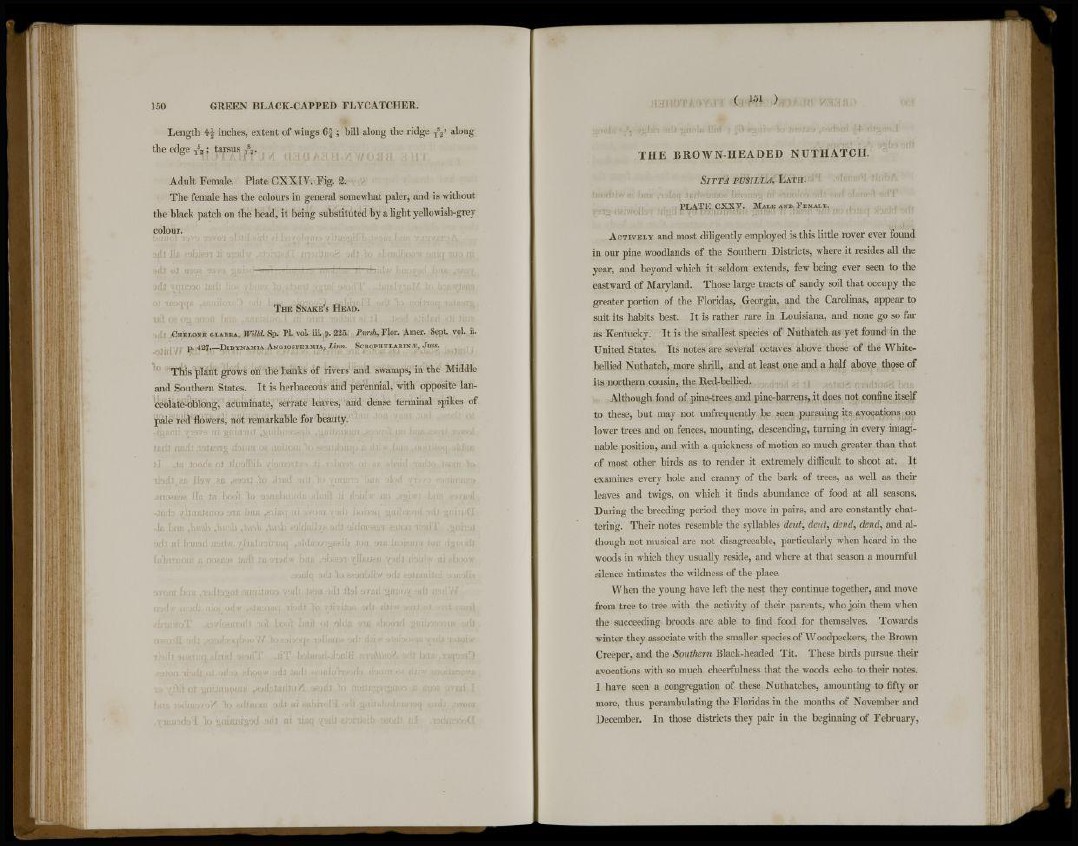
150 GREEN BLACK-CAPPED FLYCATCHER.
Length 4^ inches, extent of wings 6f ; bill along the ridge T
3
5 ' along
the edge T
5
2 ; tarsus
Adult Female. Plate CXXIV. Fig. %
The female has the colours in general somewhat paler, and is without
the black patch on the head, it being substituted by alight yellowish-grey
colour.
THE SNAKE'S HEAD.
C H E L O N E G L A B R A , Willd. Sp. PL voL in. p. 225. Pursh, Flor. Amer. Sept. vol. ii.
p. 4 2 7 . — D I D Y N A M I A A N G I O S P E R M I A , Linn. SCROPHULARIN"/E, Juss.
This plant grows on the banks of rivers and swamps, in the Middle
and Southern States. It is herbaceous and perennial, with opposite lanceolate
oblong, acuminate, serrate leaves, and dense terminal spikes of
pale red flowers, not remarkable for beauty.
( ft} )
T H E BROWN-HEADED NUTHATCH.
SlTTA PUSILLA, L A T H .
P L A T E C X X V . MALE A N D F E M A L E .
ACTIVELY and most diligently employed is this little rover ever found
in our pine woodlands of the Southern Districts, where it resides all the
year, and beyond which it seldom extends, few being ever seen to the
eastward of Maryland. Those large tracts of sandy soil that occupy the
greater portion of the Floridas, Georgia, and the Carolinas, appear to
suit its habits best. It is rather rare in Louisiana, and none go so far
as Kentucky. It is the smallest species of Nuthatch as yet found in the
United States. Its notes are several octaves above those of the Whitebellied
Nuthatch, more shrill, and at least one and a half above those of
its northern cousin, the Red-bellied.
Although fond of pine-trees and pine-barrens, it does not confine itself
to these, but may not unfrequently be seen pursuing its avocations on
lower trees and on fences, mounting, descending, turning in every imaginable
position, and with a quickness of motion so much greater than that
of most other birds as to render it extremely difficult to shoot at. It
examines every hole and cranny of the bark of trees, as well as their
leaves and twigs, on which it finds abundance of food at all seasons.
During the breeding period they move in pairs, and are constantly chattering.
Their notes resemble the syllables dent, dent, dend, dend, and although
not musical are not disagreeable, particularly when heard in the
woods in which they usually reside, and where at that season a mournful
silence intimates the wildness of the place.
When the young have left the nest they continue together, and move
from tree to tree with the activity of their parents, who join them when
the succeeding broods are able to find food for themselves. Towards
winter they associate with the smaller species of Woodpeckers, the Brown
Creeper, and the Southern Black-headed Tit. These birds pursue their
avocations with so much cheerfulness that the woods echo to their notes.
I have seen a congregation of these Nuthatches, amounting to fifty or
more, thus perambulating the Floridas in the months of November and
December. In those districts they pair in the beginning of February,